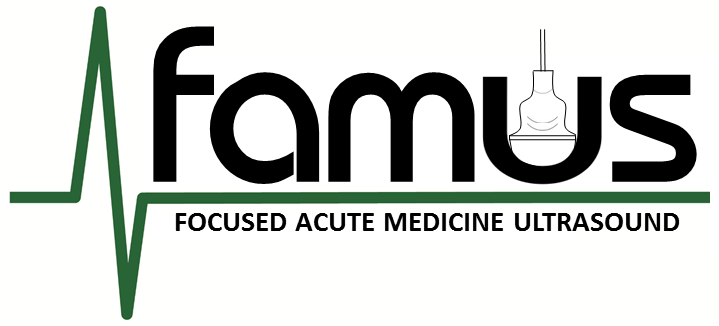This page houses a number of examples of pathologies seen when imaging the abdomen. Many of them will be during a FAMUS scan, but some will not form part of the FAMUS scan, but are shown for interest. It is hoped that the images below, with explanations, provide a useful opportunity for learning.
CBD dilation
An example of CBD dilation is shown here, with Doppler used to confirm the appearance.
Cholecystitis
The video below is an example of cholecystitis, in this case due to a gallstone at the neck of the gallbladder.
Enlarged prostate
Prostatic enlargement is a common finding (particularly in the elderly), and it is possible to try to quantify the volume of the prostate (in this case 156ml). You can see here an irregular posterior border and a grossly enlarged prostate bulk.
Free fluid
An overview of free fluid within the abdomen, in these cases due to ascites.
Hydronephrosis
Hydronephrosis of varying degrees, from mild (and unlikely to be clinically relevant) to severe which in the acute phase will always be relevant and usually mandate urgent CT KUB to assess the cause and degree of obstruction. The final video in the series shows an overview of hydronephrosis.
Liver abscess
Although uncommon, a liver abscess will be a differential in a patient with deranged LFTs +- right upper quadrant pain. This case required interventional radiology input to site two drains and a prolonged course of intravenous antibiotics.
Nephrolithiasis
Although renal colic/nephrolithiasis is not part of the FAMUS curriculum, you may well encounter it in patients with AKI and so should aim to recognise it if possible. This video shows two cases of nephrolithiasis; the first with an echodense stone and associated mild hydronephrosis, the second with a less dense stone and so less prominent acoustic shadow.
Peristalsis
Clearly not pathological, but this video highlights the definition of the abdominal organs available when patients have free fluid within the abdomen (in this case, ascites).
Polycystic kidneys
The video below shows polycystic kidneys. It is worth noting how the appearances are not dissimilar to a severe hydronephrosis. One of the key differences of course being that an adult with polycystic kidneys will likely have chronic kidney disease, whereas hydronephrosis will usually cause an acute kidney injury.
Septated ascites
In the same way that pleural fluid can become septated, so can ascitic fluid. This is particularly likely when the fluid is exudative (and/or protein rich) and with a degree of chronicity. The video below shows an example of septated ascites in a patient with malignancy.
Small bowel obstruction
Although clearly not part of the FAMUS curriculum, there is an increasing recognition that ultrasound can reliably detect small bowel obstruction with a good degree of sensitivity and specificity. As the video below highlights, there are a number of signs that can be sign. These include dilated, fluid-filled bowel (>25mm), a lack of visible peristalsis, a ‘to and fro’ movement of the bowel contents and finger-like projections visible from the bowel wall. All of these signs are visible here. Although bowel normally can be difficult to visualise, when obstructed it becomes fluid-filled and very superficial and so provides excellent acoustic windows.
Have any questions?
If you have any FAMUS queries not covered by the following pages, please check out or FAQ section. If this still doesn't answer your queries, please contact FAMUS@acutemedicine.org.uk
